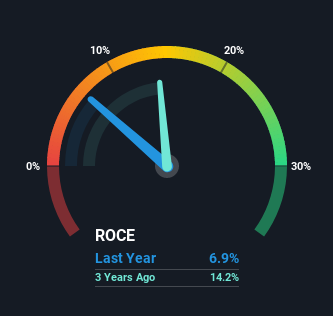Kokusai's (TYO:7722) Returns On Capital Not Reflecting Well On The Business

To avoid investing in a business that's in decline, there's a few financial metrics that can provide early indications of aging. More often than not, we'll see a declining return on capital employed (ROCE) and a declining amount of capital employed. Ultimately this means that the company is earning less per dollar invested and on top of that, it's shrinking its base of capital employed. So after glancing at the trends within Kokusai (TYO:7722), we weren't too hopeful.
Understanding Return On Capital Employed (ROCE)
If you haven't worked with ROCE before, it measures the 'return' (pre-tax profit) a company generates from capital employed in its business. The formula for this calculation on Kokusai is:
Return on Capital Employed = Earnings Before Interest and Tax (EBIT) ÷ (Total Assets - Current Liabilities)
0.069 = JP¥850m ÷ (JP¥19b - JP¥6.4b) (Based on the trailing twelve months to December 2020).
So, Kokusai has an ROCE of 6.9%. In absolute terms, that's a low return but it's around the Machinery industry average of 6.3%.
Check out our latest analysis for Kokusai

In the above chart we have measured Kokusai's prior ROCE against its prior performance, but the future is arguably more important. If you'd like to see what analysts are forecasting going forward, you should check out our free report for Kokusai.
What Can We Tell From Kokusai's ROCE Trend?
There is reason to be cautious about Kokusai, given the returns are trending downwards. About five years ago, returns on capital were 24%, however they're now substantially lower than that as we saw above. Meanwhile, capital employed in the business has stayed roughly the flat over the period. This combination can be indicative of a mature business that still has areas to deploy capital, but the returns received aren't as high due potentially to new competition or smaller margins. So because these trends aren't typically conducive to creating a multi-bagger, we wouldn't hold our breath on Kokusai becoming one if things continue as they have.
In Conclusion...
In summary, it's unfortunate that Kokusai is generating lower returns from the same amount of capital. It should come as no surprise then that the stock has fallen 28% over the last five years, so it looks like investors are recognizing these changes. With underlying trends that aren't great in these areas, we'd consider looking elsewhere.
One more thing, we've spotted 3 warning signs facing Kokusai that you might find interesting.
While Kokusai isn't earning the highest return, check out this free list of companies that are earning high returns on equity with solid balance sheets.
If you’re looking to trade a wide range of investments, open an account with the lowest-cost* platform trusted by professionals, Interactive Brokers. Their clients from over 200 countries and territories trade stocks, options, futures, forex, bonds and funds worldwide from a single integrated account. Promoted
Valuation is complex, but we're here to simplify it.
Discover if Kokusai might be undervalued or overvalued with our detailed analysis, featuring fair value estimates, potential risks, dividends, insider trades, and its financial condition.
Access Free AnalysisThis article by Simply Wall St is general in nature. It does not constitute a recommendation to buy or sell any stock, and does not take account of your objectives, or your financial situation. We aim to bring you long-term focused analysis driven by fundamental data. Note that our analysis may not factor in the latest price-sensitive company announcements or qualitative material. Simply Wall St has no position in any stocks mentioned.
*Interactive Brokers Rated Lowest Cost Broker by StockBrokers.com Annual Online Review 2020
Have feedback on this article? Concerned about the content? Get in touch with us directly. Alternatively, email editorial-team (at) simplywallst.com.
About TSE:7722
Kokusai
Engages in the manufacture and sale of testers, measurement instruments, and automatic inspection equipment for motors and rotating equipment in Japan and internationally.
Excellent balance sheet, good value and pays a dividend.
Market Insights
Community Narratives



